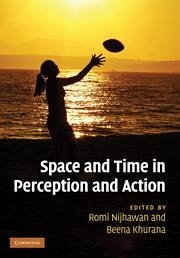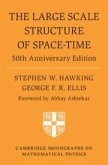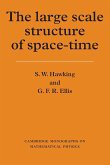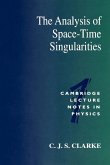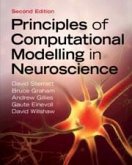Space and Time in Perception and Action
Herausgeber: Nijhawan, Romi; Khurana, Beena
Space and Time in Perception and Action
Herausgeber: Nijhawan, Romi; Khurana, Beena
- Gebundenes Buch
- Merkliste
- Auf die Merkliste
- Bewerten Bewerten
- Teilen
- Produkt teilen
- Produkterinnerung
- Produkterinnerung
Written for advanced students and neuroscientists with a particular interest in problems of space and time, this unique compilation brings together cutting edge experiments and theoretical treatments from world-leading experts in visual neuroscience and psychophysics. It focuses on illusions and errors and what they reveal about the processes underlying perception.
Andere Kunden interessierten sich auch für
![Computing Brain Activity Maps from fMRI Time-Series Images Computing Brain Activity Maps from fMRI Time-Series Images]() Gordon E. Sarty (Canada University of Saskatchewan)Computing Brain Activity Maps from fMRI Time-Series Images123,99 €
Gordon E. Sarty (Canada University of Saskatchewan)Computing Brain Activity Maps from fMRI Time-Series Images123,99 €![The Large Scale Structure of Space-Time The Large Scale Structure of Space-Time]() Stephen W. Hawking (University of Cambridge)The Large Scale Structure of Space-Time41,99 €
Stephen W. Hawking (University of Cambridge)The Large Scale Structure of Space-Time41,99 €![The Large Scale Structure of Space-Time The Large Scale Structure of Space-Time]() S. W. HawkingThe Large Scale Structure of Space-Time60,99 €
S. W. HawkingThe Large Scale Structure of Space-Time60,99 €![Society in Time and Space Society in Time and Space]() Robert A. Dodgshon (Aberystwyth University College of Wales)Society in Time and Space52,99 €
Robert A. Dodgshon (Aberystwyth University College of Wales)Society in Time and Space52,99 €![The Analysis of Space-Time Singularities The Analysis of Space-Time Singularities]() C. J. S. Clarke (University of Southampton)The Analysis of Space-Time Singularities76,99 €
C. J. S. Clarke (University of Southampton)The Analysis of Space-Time Singularities76,99 €![Principles of Computational Modelling in Neuroscience Principles of Computational Modelling in Neuroscience]() David Sterratt (University of Edinburgh)Principles of Computational Modelling in Neuroscience74,99 €
David Sterratt (University of Edinburgh)Principles of Computational Modelling in Neuroscience74,99 €![Evolution of Sleep Evolution of Sleep]() Patrick McNamara / Robert Barton / Charles Nunn (ed.)Evolution of Sleep146,99 €
Patrick McNamara / Robert Barton / Charles Nunn (ed.)Evolution of Sleep146,99 €-
-
-
Written for advanced students and neuroscientists with a particular interest in problems of space and time, this unique compilation brings together cutting edge experiments and theoretical treatments from world-leading experts in visual neuroscience and psychophysics. It focuses on illusions and errors and what they reveal about the processes underlying perception.
Hinweis: Dieser Artikel kann nur an eine deutsche Lieferadresse ausgeliefert werden.
Hinweis: Dieser Artikel kann nur an eine deutsche Lieferadresse ausgeliefert werden.
Produktdetails
- Produktdetails
- Verlag: Cambridge University Press
- Seitenzahl: 582
- Erscheinungstermin: 26. April 2010
- Englisch
- Abmessung: 253mm x 182mm x 37mm
- Gewicht: 1280g
- ISBN-13: 9780521863186
- ISBN-10: 052186318X
- Artikelnr.: 28244974
- Herstellerkennzeichnung
- Libri GmbH
- Europaallee 1
- 36244 Bad Hersfeld
- gpsr@libri.de
- Verlag: Cambridge University Press
- Seitenzahl: 582
- Erscheinungstermin: 26. April 2010
- Englisch
- Abmessung: 253mm x 182mm x 37mm
- Gewicht: 1280g
- ISBN-13: 9780521863186
- ISBN-10: 052186318X
- Artikelnr.: 28244974
- Herstellerkennzeichnung
- Libri GmbH
- Europaallee 1
- 36244 Bad Hersfeld
- gpsr@libri.de
List of contributors; 1. Space and time: the fabric of thought and reality
Beena Khurana and Romi Nijhawan; Part I. Time-space During Action:
Perisaccadic Mislocalization and Reaching: 2. The internal eye position
signal, psychophysics and neurobiology John Schlag and Madeleine
Schlag-Rey; 3. Factors influencing perisaccadic visual mislocalization
Hitoshi Honda; 4. Visual and non-visual factors in peri saccadic
compression of space Markus Lappe, Lars Michels and Holger Awater; 5.
Keeping vision stable: rapid updating of spatiotopic receptive fields may
cause relativistic-like effects M. Concetta Morrone, John Ross and David C.
Burr; 6. Combined influences of extraretinal signals, retinal signals, and
visual induction on space perception and manual behavior in perisaccadic
and steady viewing Leonard Matin and Wenxun Li; 7. Space constancy: the
rise and fall of perceptual compensation Bruce Bridgeman; 8. Intercepting
moving objects: do eye-movements matter? Eli Brenner and Jeroen B. J.
Smeets; 9. The utility of visual motion for goal directed reaching David
Whitney, Ikuya Murakami and Hiroaki Gomi; Part II. Temporal Phenomena:
Perception: 10. Saccadic chronostasis and the continuity of subjective
temporal experience across eye movements Kielan Yarrow, Patrick Haggard and
John C. Rothwell; 11. Experiencing the future: the influence of
self-initiation on temporal perception Timothy Verstynen, Michael Oliver
and Richard B. Ivry; 12. On the perceived interdependence of space and
time: evidence for spatial priming in the temporal kappa effect Gisa
Aschersleben and Jochen Müsseler; Part III. Temporal Phenomena: Binding and
Asynchrony: 13. Dynamics of visual feature binding Colin W. G. Clifford;
14. How does the timing of neural signals map onto the timing of
perception? David M. Eagleman; 15. Mechanisms of simultaneity constancy
Laurence Harris, Vanessa Harrar, Philip Jaekl and Agnieszka Kopinska; 16.
Relative timing and perceptual asynchrony Derek H. Arnold; 17. The time
marker account of cross-channel temporal judgments Shin'ya Nishida and Alan
Johnston; 18. Simultaneity versus asynchrony of visual motion and luminance
changes Martin J. M. Lankheet and Wim A. van de Grind; Part IV. Spatial
Phenomena: Forward Shift Effects: 19. The Fröhlich effect: past and present
Dirk Kerzel; 20. Approaches to representational momentum: theories and
models Timothy L. Hubbard; 21. Conceptual influence on flash-lag effect and
representational momentum Masayoshi Nagai, Mutsumi Suganuma, Romi Nijhawan,
Jennifer J. Freyd, Geoffrey Miller and Katsumi Watanabe; 22. Perceptual
asynchronies and the dual-channel differential latency hypothesis H.
Kafaligönül, S. S. Patel, H. Ö¿men, H. E. Bedell and G. Purushothaman; 23.
Paying attention to the flash-lag effect Marcus V. C. Baldo and Stanley A.
Klein; 24. Illusions of time, space and motion: flash-lag meets chopsticks
and reversed phi Stuart Anstis; 25. Bridging the gap: a model of common
neural mechanisms underlying the Fröhlich effect, the flash-lag effect, and
the representational momentum effect Dirk Jancke and Wolfram Erlhagen; 26.
Perceiving-the-present and a unifying theory of illusions Mark A. Changizi,
Andrew Hsieh, Romi Nijhawan, Ryoto Kanai and Shinsuke Shimojo; 27. History
and theory of flash-lag: past, present and future Gerrit Maus, Beena
Khurana and Romi Nijhawan; Part V. Space-time and Awareness: 28. Object
updating: a force for perceptual continuity and scene stability in human
vision James T. Enns, Alejandro Lleras and Cathleen M. Moore; 29. A motion
illusion reveals the temporally discrete nature of visual awareness Rufin
VanRullen, Leila Reddy and Christof Koch; 30. Priming and retouch in
flash-lag and other phenomena of the streaming perceptual input Talis
Bachmann; Index.
Beena Khurana and Romi Nijhawan; Part I. Time-space During Action:
Perisaccadic Mislocalization and Reaching: 2. The internal eye position
signal, psychophysics and neurobiology John Schlag and Madeleine
Schlag-Rey; 3. Factors influencing perisaccadic visual mislocalization
Hitoshi Honda; 4. Visual and non-visual factors in peri saccadic
compression of space Markus Lappe, Lars Michels and Holger Awater; 5.
Keeping vision stable: rapid updating of spatiotopic receptive fields may
cause relativistic-like effects M. Concetta Morrone, John Ross and David C.
Burr; 6. Combined influences of extraretinal signals, retinal signals, and
visual induction on space perception and manual behavior in perisaccadic
and steady viewing Leonard Matin and Wenxun Li; 7. Space constancy: the
rise and fall of perceptual compensation Bruce Bridgeman; 8. Intercepting
moving objects: do eye-movements matter? Eli Brenner and Jeroen B. J.
Smeets; 9. The utility of visual motion for goal directed reaching David
Whitney, Ikuya Murakami and Hiroaki Gomi; Part II. Temporal Phenomena:
Perception: 10. Saccadic chronostasis and the continuity of subjective
temporal experience across eye movements Kielan Yarrow, Patrick Haggard and
John C. Rothwell; 11. Experiencing the future: the influence of
self-initiation on temporal perception Timothy Verstynen, Michael Oliver
and Richard B. Ivry; 12. On the perceived interdependence of space and
time: evidence for spatial priming in the temporal kappa effect Gisa
Aschersleben and Jochen Müsseler; Part III. Temporal Phenomena: Binding and
Asynchrony: 13. Dynamics of visual feature binding Colin W. G. Clifford;
14. How does the timing of neural signals map onto the timing of
perception? David M. Eagleman; 15. Mechanisms of simultaneity constancy
Laurence Harris, Vanessa Harrar, Philip Jaekl and Agnieszka Kopinska; 16.
Relative timing and perceptual asynchrony Derek H. Arnold; 17. The time
marker account of cross-channel temporal judgments Shin'ya Nishida and Alan
Johnston; 18. Simultaneity versus asynchrony of visual motion and luminance
changes Martin J. M. Lankheet and Wim A. van de Grind; Part IV. Spatial
Phenomena: Forward Shift Effects: 19. The Fröhlich effect: past and present
Dirk Kerzel; 20. Approaches to representational momentum: theories and
models Timothy L. Hubbard; 21. Conceptual influence on flash-lag effect and
representational momentum Masayoshi Nagai, Mutsumi Suganuma, Romi Nijhawan,
Jennifer J. Freyd, Geoffrey Miller and Katsumi Watanabe; 22. Perceptual
asynchronies and the dual-channel differential latency hypothesis H.
Kafaligönül, S. S. Patel, H. Ö¿men, H. E. Bedell and G. Purushothaman; 23.
Paying attention to the flash-lag effect Marcus V. C. Baldo and Stanley A.
Klein; 24. Illusions of time, space and motion: flash-lag meets chopsticks
and reversed phi Stuart Anstis; 25. Bridging the gap: a model of common
neural mechanisms underlying the Fröhlich effect, the flash-lag effect, and
the representational momentum effect Dirk Jancke and Wolfram Erlhagen; 26.
Perceiving-the-present and a unifying theory of illusions Mark A. Changizi,
Andrew Hsieh, Romi Nijhawan, Ryoto Kanai and Shinsuke Shimojo; 27. History
and theory of flash-lag: past, present and future Gerrit Maus, Beena
Khurana and Romi Nijhawan; Part V. Space-time and Awareness: 28. Object
updating: a force for perceptual continuity and scene stability in human
vision James T. Enns, Alejandro Lleras and Cathleen M. Moore; 29. A motion
illusion reveals the temporally discrete nature of visual awareness Rufin
VanRullen, Leila Reddy and Christof Koch; 30. Priming and retouch in
flash-lag and other phenomena of the streaming perceptual input Talis
Bachmann; Index.
List of contributors; 1. Space and time: the fabric of thought and reality
Beena Khurana and Romi Nijhawan; Part I. Time-space During Action:
Perisaccadic Mislocalization and Reaching: 2. The internal eye position
signal, psychophysics and neurobiology John Schlag and Madeleine
Schlag-Rey; 3. Factors influencing perisaccadic visual mislocalization
Hitoshi Honda; 4. Visual and non-visual factors in peri saccadic
compression of space Markus Lappe, Lars Michels and Holger Awater; 5.
Keeping vision stable: rapid updating of spatiotopic receptive fields may
cause relativistic-like effects M. Concetta Morrone, John Ross and David C.
Burr; 6. Combined influences of extraretinal signals, retinal signals, and
visual induction on space perception and manual behavior in perisaccadic
and steady viewing Leonard Matin and Wenxun Li; 7. Space constancy: the
rise and fall of perceptual compensation Bruce Bridgeman; 8. Intercepting
moving objects: do eye-movements matter? Eli Brenner and Jeroen B. J.
Smeets; 9. The utility of visual motion for goal directed reaching David
Whitney, Ikuya Murakami and Hiroaki Gomi; Part II. Temporal Phenomena:
Perception: 10. Saccadic chronostasis and the continuity of subjective
temporal experience across eye movements Kielan Yarrow, Patrick Haggard and
John C. Rothwell; 11. Experiencing the future: the influence of
self-initiation on temporal perception Timothy Verstynen, Michael Oliver
and Richard B. Ivry; 12. On the perceived interdependence of space and
time: evidence for spatial priming in the temporal kappa effect Gisa
Aschersleben and Jochen Müsseler; Part III. Temporal Phenomena: Binding and
Asynchrony: 13. Dynamics of visual feature binding Colin W. G. Clifford;
14. How does the timing of neural signals map onto the timing of
perception? David M. Eagleman; 15. Mechanisms of simultaneity constancy
Laurence Harris, Vanessa Harrar, Philip Jaekl and Agnieszka Kopinska; 16.
Relative timing and perceptual asynchrony Derek H. Arnold; 17. The time
marker account of cross-channel temporal judgments Shin'ya Nishida and Alan
Johnston; 18. Simultaneity versus asynchrony of visual motion and luminance
changes Martin J. M. Lankheet and Wim A. van de Grind; Part IV. Spatial
Phenomena: Forward Shift Effects: 19. The Fröhlich effect: past and present
Dirk Kerzel; 20. Approaches to representational momentum: theories and
models Timothy L. Hubbard; 21. Conceptual influence on flash-lag effect and
representational momentum Masayoshi Nagai, Mutsumi Suganuma, Romi Nijhawan,
Jennifer J. Freyd, Geoffrey Miller and Katsumi Watanabe; 22. Perceptual
asynchronies and the dual-channel differential latency hypothesis H.
Kafaligönül, S. S. Patel, H. Ö¿men, H. E. Bedell and G. Purushothaman; 23.
Paying attention to the flash-lag effect Marcus V. C. Baldo and Stanley A.
Klein; 24. Illusions of time, space and motion: flash-lag meets chopsticks
and reversed phi Stuart Anstis; 25. Bridging the gap: a model of common
neural mechanisms underlying the Fröhlich effect, the flash-lag effect, and
the representational momentum effect Dirk Jancke and Wolfram Erlhagen; 26.
Perceiving-the-present and a unifying theory of illusions Mark A. Changizi,
Andrew Hsieh, Romi Nijhawan, Ryoto Kanai and Shinsuke Shimojo; 27. History
and theory of flash-lag: past, present and future Gerrit Maus, Beena
Khurana and Romi Nijhawan; Part V. Space-time and Awareness: 28. Object
updating: a force for perceptual continuity and scene stability in human
vision James T. Enns, Alejandro Lleras and Cathleen M. Moore; 29. A motion
illusion reveals the temporally discrete nature of visual awareness Rufin
VanRullen, Leila Reddy and Christof Koch; 30. Priming and retouch in
flash-lag and other phenomena of the streaming perceptual input Talis
Bachmann; Index.
Beena Khurana and Romi Nijhawan; Part I. Time-space During Action:
Perisaccadic Mislocalization and Reaching: 2. The internal eye position
signal, psychophysics and neurobiology John Schlag and Madeleine
Schlag-Rey; 3. Factors influencing perisaccadic visual mislocalization
Hitoshi Honda; 4. Visual and non-visual factors in peri saccadic
compression of space Markus Lappe, Lars Michels and Holger Awater; 5.
Keeping vision stable: rapid updating of spatiotopic receptive fields may
cause relativistic-like effects M. Concetta Morrone, John Ross and David C.
Burr; 6. Combined influences of extraretinal signals, retinal signals, and
visual induction on space perception and manual behavior in perisaccadic
and steady viewing Leonard Matin and Wenxun Li; 7. Space constancy: the
rise and fall of perceptual compensation Bruce Bridgeman; 8. Intercepting
moving objects: do eye-movements matter? Eli Brenner and Jeroen B. J.
Smeets; 9. The utility of visual motion for goal directed reaching David
Whitney, Ikuya Murakami and Hiroaki Gomi; Part II. Temporal Phenomena:
Perception: 10. Saccadic chronostasis and the continuity of subjective
temporal experience across eye movements Kielan Yarrow, Patrick Haggard and
John C. Rothwell; 11. Experiencing the future: the influence of
self-initiation on temporal perception Timothy Verstynen, Michael Oliver
and Richard B. Ivry; 12. On the perceived interdependence of space and
time: evidence for spatial priming in the temporal kappa effect Gisa
Aschersleben and Jochen Müsseler; Part III. Temporal Phenomena: Binding and
Asynchrony: 13. Dynamics of visual feature binding Colin W. G. Clifford;
14. How does the timing of neural signals map onto the timing of
perception? David M. Eagleman; 15. Mechanisms of simultaneity constancy
Laurence Harris, Vanessa Harrar, Philip Jaekl and Agnieszka Kopinska; 16.
Relative timing and perceptual asynchrony Derek H. Arnold; 17. The time
marker account of cross-channel temporal judgments Shin'ya Nishida and Alan
Johnston; 18. Simultaneity versus asynchrony of visual motion and luminance
changes Martin J. M. Lankheet and Wim A. van de Grind; Part IV. Spatial
Phenomena: Forward Shift Effects: 19. The Fröhlich effect: past and present
Dirk Kerzel; 20. Approaches to representational momentum: theories and
models Timothy L. Hubbard; 21. Conceptual influence on flash-lag effect and
representational momentum Masayoshi Nagai, Mutsumi Suganuma, Romi Nijhawan,
Jennifer J. Freyd, Geoffrey Miller and Katsumi Watanabe; 22. Perceptual
asynchronies and the dual-channel differential latency hypothesis H.
Kafaligönül, S. S. Patel, H. Ö¿men, H. E. Bedell and G. Purushothaman; 23.
Paying attention to the flash-lag effect Marcus V. C. Baldo and Stanley A.
Klein; 24. Illusions of time, space and motion: flash-lag meets chopsticks
and reversed phi Stuart Anstis; 25. Bridging the gap: a model of common
neural mechanisms underlying the Fröhlich effect, the flash-lag effect, and
the representational momentum effect Dirk Jancke and Wolfram Erlhagen; 26.
Perceiving-the-present and a unifying theory of illusions Mark A. Changizi,
Andrew Hsieh, Romi Nijhawan, Ryoto Kanai and Shinsuke Shimojo; 27. History
and theory of flash-lag: past, present and future Gerrit Maus, Beena
Khurana and Romi Nijhawan; Part V. Space-time and Awareness: 28. Object
updating: a force for perceptual continuity and scene stability in human
vision James T. Enns, Alejandro Lleras and Cathleen M. Moore; 29. A motion
illusion reveals the temporally discrete nature of visual awareness Rufin
VanRullen, Leila Reddy and Christof Koch; 30. Priming and retouch in
flash-lag and other phenomena of the streaming perceptual input Talis
Bachmann; Index.

